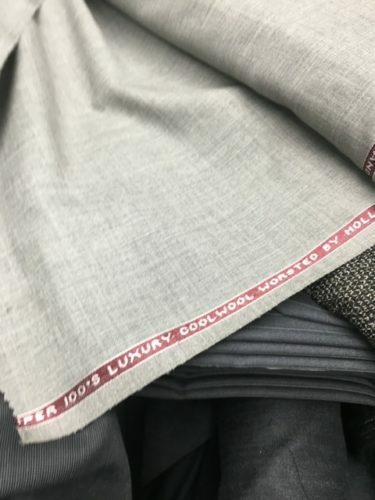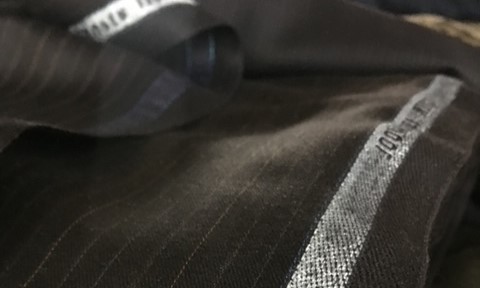By Bryan Ergle
Let us step back for a moment, before we go into the ‘where’, and touch upon ‘what’… choosing the right fabric! And in that, is the beginning of a good suit. We’ve now discussed how the shortcomings of many offerings from lower-end semi-custom (sometimes called Made-to-Measure, or MTM/M2M) places fall on the fact that their prices simply do not allow for quality materials to be used, and even with some off-the-rack offerings, the material is dubious, at best. Still, the materials used are at the core of a good suit.
The main ingredient in the recipe that is a well-sewn suit is the one that is the most visible, and the most obvious: the fabric. It may not seem like it is something worth lending much thought to… after all, you likely never stop to think about who makes the fabric that is in your shirts, or your slacks, or your jeans (not yet, but you will, in time!) Then again, you likely aren’t paying over a thousand dollars for your shirts or jeans, and you don’t usually expect those to last nearly as long as a good suit, nor to be as durably versatile.
As we’re going to be focusing on custom/semi-custom suiting, you have the advantage in that you get to choose what your suit is going to be, from the outset, and that includes the fabric, whether you purchase it from/through your tailor, or buy it yourself and bring it to them. So let’s dive into suiting fabric, and what your options are.
First, it matters which mill makes your fabric. There are tons of unnamed mills around, but you never know what quality you’re getting, so it is best to stick with mills that have reputations for exceptional quality. I would recommend:
- English:
- Scabal
- Holland & Sherry
- French:
- Dormeuil
- Italian:
- Loro Piana
- Vitale Barberis
Second, the material itself. There are blends and variations to suit (no pun intended) every imagination, but in truth, there is a reason that worsted wool is the first, best choice for almost all suits. This is triply true if it is your first custom suit, or your first suit period. Wool, well made and of the proper weight, is durable, stylish, drapes well on a suit, and turns out beautifully. Other materials can be worked into suits, and you’ll hear about those over time here at Well Sewn, from wool and silk blends, mohair and wool, cotton and mohair, etc etc. You’ve also got pure silk, linen, flannel, and more. But wool is your primary. When it comes to suits, wool is your spouse, the dedicated, long-term love of your life.
Intriguing aside, courtesy of Gentleman’s Gazette: “You might be surprised to learn that the wool used to manufacture a great many suits globally comes from sheep which are descended from just two rams and four ewes. In 1789, King Charles the fourth of Spain gifted six sheep to the Dutch East India Company; these sheep were then shipped to South Africa. In 1795, a British immigrant to Australia named John McArthur bought 26 of the offspring of these original six sheep and transported them back to botany bay. These 26 sheep were then bred to form the backbone of what’s now the Australian wool industry which has sheep that now number more than one hundred and twenty million. The wool from these sheep produced in grades between 60s and 80s around this time, essentially measuring how fine the yarns were, was top of the line. As such, most of it went directly to tailors on Savile Row. 100s grade wool meanwhile was thought to be unattainable at this time in history.”
 When you start looking for fabric, you’re likely to see ‘super’ numbers – Super 80, Super 120, Super 150, and so-on. This number is, put simply, how finely made the individual thread fibers are in the fabric itself… how big their diameter is. So, a lower number, like Super 80, will have larger fibers, making the fabric seem slightly heavier, and rougher to the touch, while it gets less so of both the higher you go… lighter, smoother, softer.
When you start looking for fabric, you’re likely to see ‘super’ numbers – Super 80, Super 120, Super 150, and so-on. This number is, put simply, how finely made the individual thread fibers are in the fabric itself… how big their diameter is. So, a lower number, like Super 80, will have larger fibers, making the fabric seem slightly heavier, and rougher to the touch, while it gets less so of both the higher you go… lighter, smoother, softer.
I know what you’re thinking, but slow down there, don’t jump ahead. Before you go out and buy a Super 220 fabric for your next suit, know that there is a trade-off… those thinner fibers mean the fabric is likely to be less durable, the drape will be harder to get right, and while soft to the touch, can be prone to wrinkles, and more. Even going as high as 160 or above runs into dangerous territory with working an unknown fabric, particularly if you don’t yet have a good, established relationship with your tailor.
So, are you confused yet? Don’t be, it’s not as complex as it sounds. You don’t want your fabric to be overly rough and wooly, but you don’t want to look like you’re wearing a wrinkled polyester rag from the 70’s, so you go for the sweet spot: stick to Super 100-Super 120. These will be excellent fabrics for long-term wear, excellent drape, and a reliably good look.
Now you’ve got your material and the Super number all figured out, and at least roughly where you want it to come from, you’re in good shape! A lot of what comes next is personal preference… what color fabric/suit do you want, do you want a two-piece, or a three-piece, or maybe a two-piece and an extra set of trousers, etc. Those will determine what color, and how much fabric you get. For the amount of fabric, number of yards, there are any number of places online you can find a breakdown, but the general rule I would suggest is 3.7-4 yards for a two-piece, 5-5.5 yards for a three-piece. You may have extra, but much like a football team, the first time anything goes wrong, you’ll be glad for the extra yardage. If you’re taller, or have a heavier build, this number increases. If in doubt, ask your tailor before buying!
For color, this one is subjective, there’s no two ways around it. Your bread and butter are colors based in navy blue, and dark gray. Maybe you want plain, maybe some pinstripes or chalk stripes on your blue, or a Prince of Wales check pattern on your gray, but the base color is the first thing people will see. It’s your suit, it needs to suit you… we just want to make sure to try to help you get shuttle launched, so to speak – you get to decide where it goes!




One Reply to “Men’s Suits Series, Part IV – On Choosing Fabric”
דירות דיסקרטיות בהרצליה
Can I simply just say what a comfort to discover an individual who genuinely knows what they are discussing on the internet. You definitely realize how to bring an issue to light and make it important. More people should look at this and understand this side of the story. I was surprised that youre not more popular since you surely possess the gift.